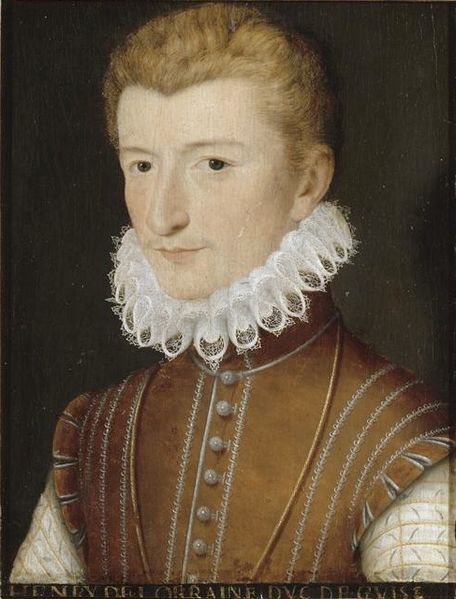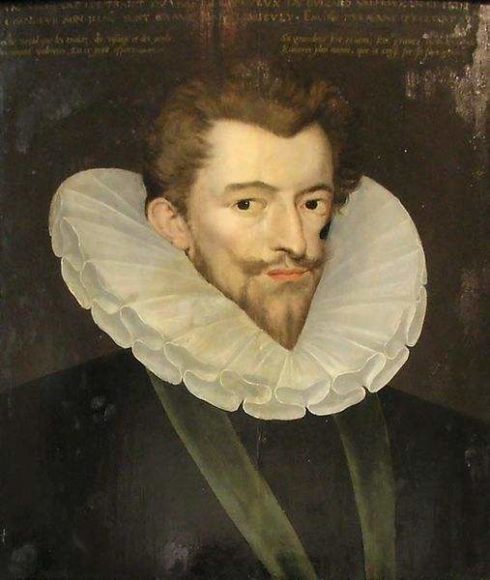HENRI I DE LORRAINE
Prince de Joinville, and in 1563 third Duke of Guise, born 31 Dec. 1550, the son of François de Guise and Anne d’Este; died at Blois, 23 Dec., 1588.
The rumours which attributed to Coligny a share in the murder of François de Guise hailed in the young Henri de Guise, then thirteen years old, the avenger of his father and the leader of the Catholic party. While the Cardinal of Lorraine retained the ascendancy and the numerous following of his family, the young Henri, leaving France, had no part in the patched-up reconciliation at Moulins between his mother and Coligny. In July, 1556, he went to Hungary to fight in the emperor’s service against the Turks. When he returned to France he took part in the second and third Huguenot wars, distinguishing himself at the battles of Saint-Denis (1567), Jarnac, Moncontour, and at the defence of Portiers (1569) against Coligny. His pretension (1570) to the hand of Margaret of Valois, sister of Charles IX, seriously offended the king, but he was restored to favour on his hastily marrying Catherine de Clèves (1548-1633), widow of the Prince of Porcien and goddaughter of Catharine de’ Medici, noted for the frivolity of her youth and for the strange freedom with which she had caused her lovers to be painted in her Book of Hours as crucified.
Between 1570 and 1572 Henri de Guise was much disturbed by the ascendancy of Coligny and the Protestants in the counsels of Charles IX. To similar suspicious fears, shared by Catharine de’ Medici, must be traced the St. Bartholomew massacre. Guise was accused of having given the impulse by stationing Maurevers (22 Aug., 1572) on the route taken by Coligny, and when the next day Catharine de’ Medici insisted that, in order to forestall an outbreak of Protestant vengeance, Charles IX should order the death of several of their chiefs, Guise was summoned to the palace to arrange for the execution of the plan. For the massacre and the deplorable proportions it assumed, see Saint Bartholomew’s Day. During the night of 24 August, Henri de Guise, with a body of armed men, went to Coligny’s dwelling, and while his attendants slew Coligny, he waited on horseback in the courtyard and cried, “Is he quite dead?” In repelling the repeated attacks of the Huguenots at the battle of Dormans (10 Oct. 1575) during the Huguenot war, Henri received a wound on the cheek which led to his being thenceforth known, like his father, as Le Balafré. His power increased, and he was regarded as a second Judas Machabeus. His popularity was now so great that a contemporary wrote, “It is too little to say that France was in love with that man; she was bewitched by him.”
King Henry III began to feel that his own safety was threatened, the powerful family was beginning to aspire to the throne. In 1576 the Holy League was organized, centered at once about the popular hero, Henri de Guise, and in a few months had at its disposal 26,000 infantry and 5000 cavalry. The object of the League was to defend the Catholic religion in France. Still earlier at Toulouse (1563), Angers (1565), Dijon (1567), Bourges and Troyes (1568), Catholic leagues had been formed, composed of loyal and pious middle class citizens. In 1576, however, the Holy League was established among the nobility and, according to a declaration spread throughout France by Guise, this association of princes, lords, and gentlemen had a twofold purpose: (1) to establish in its fullness the law of God; to restore and maintain God’s holy service according to the form and manner of the Holy, Catholic, Apostolic, and Roman church; to preserve king Henry III in the state of splendour, authority, duty, and obedience owed to him by his subjects, but with the proviso that nothing shall be done to the prejudice of what may be enjoined by the States-General. (2) To restore to the provinces and states of the realm, under the protection of the League, their ancient rights, pre-eminence, franchises and liberties such as they have been from the time of Clovis, the first Christian king, and as much better and more profitable, if improvement were possible, as they could be made under the protection of the League. From the beginning, therefore, a decentralizing as well as a Catholic tendency characterized the League.
The Huguenots soon pretended to have discovered among the papers of one Jean David that the Guises had forwarded to Rome a memoir claiming that, by reason of their descent from Charlemagne, Henry III should yield them the throne of France.
The League was first organized in Picardy, under the direction of the Maréchal de Humiéres, governor of Péronne, Roye, and Montdider, then in other provinces, and finally in Paris, under the direction of the avocat, Pierre Henequin, and the Labruyères, father and son. Henry III, fearing to become a prisoner of the Catholic forces, immediately signed with the Protestants the Peace of Beaulieu, by which he granted them important concessions, but at the States-General (November-December, 1576, the influence of the League was preponderant. By the edict of 1 Jan, 1577, the Court annulled the Peace of Beaulieu, and Henry III even joined the League. This was the signal for two new religious wars, during which the military talents and Catholic zeal of Henri de Guise naturally contrasted with the cowardice and wavering policy of the king. The former stood out more and more distinctly as the leader of the Catholic party, while Henry of Navarre, the future Henry IV, now posed as the champion of the Protestants.
In the meantime occurred the death of Francis of Valois (10 June, 1584), brother of Henry III and heir presumptive to the throne. It was at once obvious that the Valois dynasty would become extinct with Henry III, and that Henry of Navarre, leader of the Protestants, would be the natural heir to the throne. Henri de Guise and the League determined at once to provide against the possibility of such an event. On the one hand, pamphleteers and genealogists, with an eye to the future, wrote countless brochures to prove that the Guises were the real descendants of Charlemagne, and that, like Pepin the Short,they might, with the assistance of the Holy See ascend the throne of France. On the other hand Henri de Guise concluded the Treaty of Joinville (31 Dec., 1584) with Philip II of Spain, and had it ratified by Sixtus V. This stipulated that, at the death of Henry III, the Cardinal de Bourbon, Archbishop of Rouen (1520-90), the third son of Charles de Bourbon, Duke of Vendôme, should be recognized as heir to the crown, “to the exclusion of all French princes of the blood at present heretics and relapsed”. The Cardinal de Bourbon published a manifesto to this effect (1 April, 1585). Philip II of Spain granted the League a subsidy of 50,000 crowns a month; moreover the clergy and lower middle classes of Paris organized for the Catholic defence, although the municipality was hostile to the League.
Civil war now broke out, and by the treaty of Namours Henry III took sides with the League and revoke all edicts which granted liberty to Protestants (18 July, 1585). When Sixtus V was assured that Henry III and Henri de Guise had come to an agreement, he launched a Bull of excommunication against the future Henry IV. So long as he was solicited to uphold the Guises against Henry III, the pope had temporized, but now that the League was operating under royal authority, he interfered in favour of the movement. The Guises in the meantime roused all Champagne and Picardy, and took Toul and Verdun. Their lieutenant, Anne de Joyeuse, was defeated at Coutras by Henry of Navarre, but the victories of Henri de Guise at Vimory (26 Oct., 1587) compelled the withdrawal of the German Protestant troops. A secret committee organized the League at Paris. In the provinces it was supported by the nobility, but in Paris it drew its strength from the common people and the religious orders. The secret committee, at first five members, then sixteen, divided Paris into quarters, and in each quarter made preparation for war. Soon 30,000 Parisians declared themselves ready to serve Guise, while in the pulpits the preachers of the League upheld in impassioned language the rights of the people and of the pope. Furthermore, by agreement with Philip II, Guise sent the Duc d’Aumale to overthrow the strongholds of Picardy, in order to assure by this means a way of retreat to the Invincible Armada, which was being sent to England to avenge Mary Stuart, niece of François de Guise, executed at the command of Elizabeth (8 Feb., 1587).
Henry III now took fright and ordered Henri de Guise to remain in his government of Champagne; he entered Paris, nevertheless, in defiance of the king (9 May, 1588), and was welcomed with enthusiasm by the masses. Repairing to the Louvre, accompanied by 400 gentlemen, he called on Henry III to establish the Inquisition and promulgate in France the decrees of the Council of Trent. The king protested and sought to bring troops to Paris on whom he might rely. A riot then broke out, and the people were about to march on the Louvre (Day of the Barricades, 12 May, 1588), but Guise, on horseback and unarmed, rode about Paris calming them. He felt assured that the king, who had made him fine promises, was thenceforth in his hands. The former, however, to escape Guise’s tutelage, withdrew on the morrow to Chartres.
Guise was now absolute master of Paris, and for some days was all-powerful. The brilliancy of his victory, however, encouraged the extremist of the League. The Sixteen, now in possession of the municipalities, committed many excesses, while such preachers as Boucher, Guincestre, and Pighenat, cried loudly for civil war. Feeling that he was overruled, Guise now offered to treat with the king, and the latter signed the Edict of Union at Rouen (10 July, 1588), by which he ratified the League, gave Guise various offices of trust, and made him lieutenant-general of the kingdom in opposition to the Protestants, barred Henry of Navarre from succession to the throne, and promised the immediate convocation of the States-general. In this way Henry III gained time.
The States-General assembled at Blois (Sept.-Dec. 1588), the members of the League being in control. Speeches were made, some aristocratic in sentiment, others democratic, but all against royal absolutism; and Guise was thenceforth the leader, not only of a religious, but also of a political movement. The members of the assembly treated Henry II as a sluggard king; the rôle of Guise resembled that of Charlemagne’s forebears under the last Merovingians.
 At this junction, Henry III determined to rid himself of Guise, and his death was decided upon. Upon taking his seat at table (22 Dec., 1588) Guise found beneath his napkin a note which warned him that a plot was on foot against him. Below the warning he wrote, “None would dare”, and threw it away. The next morning he was summoned to Henry III, and was slain by the guards. A carpet was thrown over his body, and the courtiers made sarcastic speeches as they passed, calling him the “handsome king of Paris”. Henry III left his apartments to kick the dead man in the face. That same night, Louis, Cardinal of Guise (1555-88), brother of Henri, was assassinated by four archers of the king, who feared less the cardinal should become a peril to the State. The bodies of the two leaders of the League were burned and thrown into the Loire. This double assassination was at once the subject of a multitude of pamphlets.
At this junction, Henry III determined to rid himself of Guise, and his death was decided upon. Upon taking his seat at table (22 Dec., 1588) Guise found beneath his napkin a note which warned him that a plot was on foot against him. Below the warning he wrote, “None would dare”, and threw it away. The next morning he was summoned to Henry III, and was slain by the guards. A carpet was thrown over his body, and the courtiers made sarcastic speeches as they passed, calling him the “handsome king of Paris”. Henry III left his apartments to kick the dead man in the face. That same night, Louis, Cardinal of Guise (1555-88), brother of Henri, was assassinated by four archers of the king, who feared less the cardinal should become a peril to the State. The bodies of the two leaders of the League were burned and thrown into the Loire. This double assassination was at once the subject of a multitude of pamphlets.
By Catherine de Clèves, Henri de Guise had seven daughters and seven sons, on one of whom, François-Alexandre (1589-1614), a posthumous son, the enthusiastic Parisians bestowed a third name, Paris.
Contemporary documents: Mémoires-journaux du duc François de Guise in Collection Michaud et Poujoulat; Correspondance de François de Lorraine avec Christophe, duc de Würtemberg, in Bulletin de la Société de l’histoire du protestantisme français, XXIV (1875); Mémoires de la Ligue (Amsterdam, 1758); Aubigné, Histoire universelle, ed. Ruble, I-IX (Paris, 1886-97); de Thou, Histoire universelle (London, 1773); Mémoires journaux de l’Estoile; Mathieu, Histoire des derniers troubles de France depuis les premiers mouvements de la Ligue jusqu’à la clôture des Etats à Blois (Lyons, 1597); Journal de siège de Paris, ed. Franklin (Paris, 1876); Palma Cayet, Chronologie novénaire (1589-98); journal d’un curé liguer, ed. Barthélémy (Paris, 1886).Historical works: de Bouiullé, Histoire des ducs de Guise (4 vols., Paris, 1849); de Croze, Les Guise, les Valois et Philippe II (2 vols., Paris, 1866); Forneron, Les ducs du Guise et leur époque (2 vols., Paris, 1878); de Lacombe, Catherine de Médicis entre Guise et Condé (Paris, 1899); Romier, Le maréchal de Saint-André (Paris, 1909); Chalambert, Histoire de la Ligue (2 vols, Paris, 1854); de l’Epinois, La Ligue et les Papes (Paris, 1886); Labitte, De la démocratie chez les prédicateurs de la Ligue (Paris, 1841); Zeller, Le mouvement Guisard en 1588 in Revue historique, XLI (1889). For special treatment of Cardinal de Lorraine’s connection with the Council of Trent, consult Dupuy, Instructions et lettres des rois très chrétiens et des leurs ambassadeurs concernant le concile de Trente (Paris, 1654); Hanotaux, Instructions données aux ambassadeurs et ministres de France à Rome (Paris, 1888), preface. lxvi-lxxiii.
GEORGES GOYAU (cfr. Catholic Encyclopedia)













